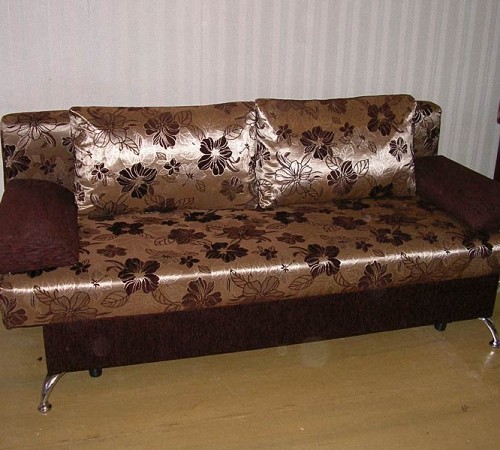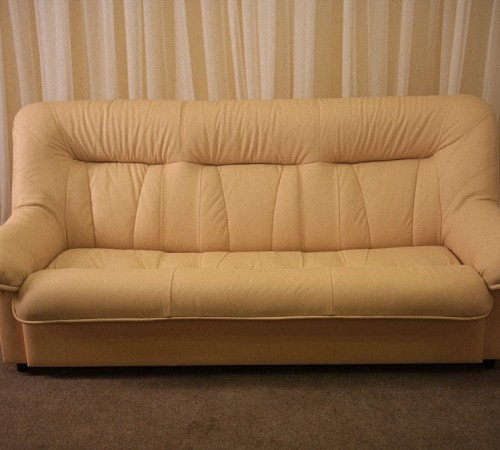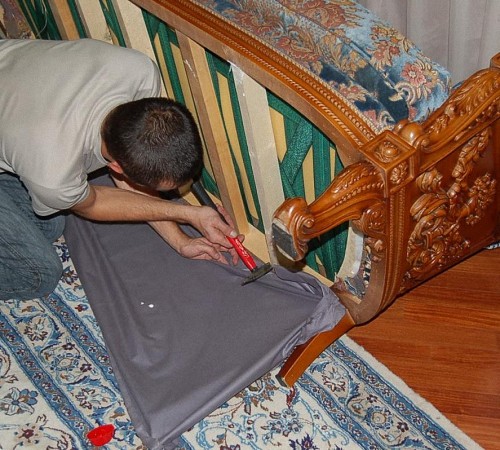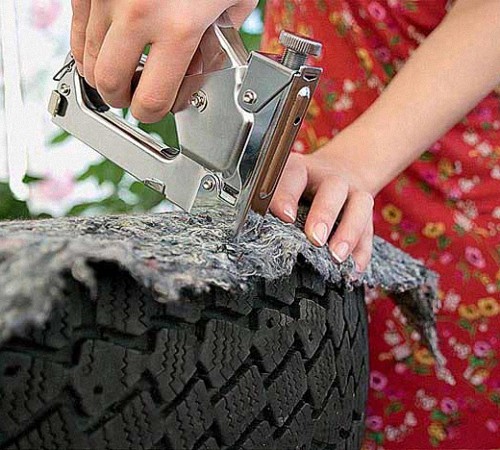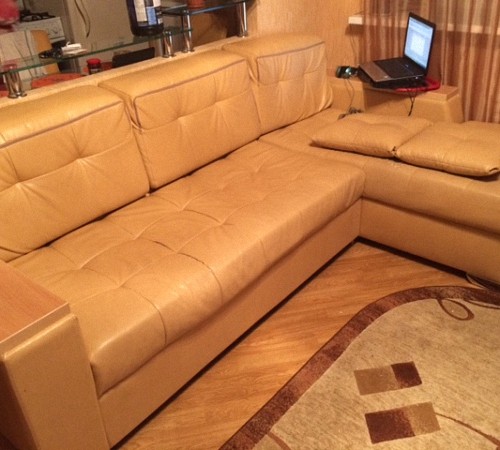No matter how solid, comfortable and high -quality upholstered furniture is, over time, the upholstery wear out and the sofa becomes unusable. And not only the appearance spoils, some constructive details become unusable, the springs are deformed, the filler is crushed, restoration and cleaning are required. Often it is necessary to restore not new upholstered furniture, but, for example, donated, given or antique. In the presence of finances, you can give furniture for hauling to a specialized company, but this simple process can be mastered independently. About how to pull the sofa, it is worth talking in detail.
Content
Where to start the restoration and upholstery of the sofa
If upholstered furniture in the house is similar in design, but has different upholstery and degree of deterioration, you can make a clip of the entire kit at the same time, having received a kind of furniture set. Although this will pull additional costs, but the update of furniture will cost several times cheaper than its complete replacement for a new one. If you master the piercing of the sofa, then changing the upholstery of armchairs and chairs with soft backs for you will not be difficult. But it is easier to start with the couch, since it contains fewer different structural details, and the surfaces themselves are larger, and it is much easier to hide the seams and a hem of the fabric.
Starting to restoration, it is important to think over all the stages of work:
- identify all the defects that arose when using a sofa;
- determine the type of upholstery;
- calculate the fifth of the upholstery;
- make preliminary calculations on expenses;
- purchase upholstery fabric;
- prepare all the necessary tools;
- disassemble the sofa;
- carry out general cleaning inside;
- make the necessary restoration;
- petamously pull the sofa.
No idea how the sofa is arranged inside, do not rush to get down to business. The easiest way is to make a pitch of a sofa with simple constructive details of a geometric shape. In this case, there are no problems with complex patterns and sophisticated details.
People say that they are afraid of their eyes, and hands are done, so if doubts and questions arose, you should get acquainted with the video how to pull the sofa with your own hands. Then only patience and time are needed.
The main defects of the old sofas and signs of wear
The definition of the "old sofa" is very relative, that is, "new" is just bought. The used sofa can have different degrees of wear, and it depends on different reasons:
- degree of daily load;
- layout frequency;
- the room in which it was operated;
- additional loads, for example, when children often jumped on the couch.
The sofa on wheels experiences the highest load in the roller part of the legs, and it is important to pay attention to this. The degree of wear of the sofa is determined by:
- on legs and rollers;
- upholstery of upholstery;
- seating deformations;
- crushing the filler;
- springs stretching;
- the integrity of the layout mechanism.
It is these parts of the sofa that are subject to careful inspection and restoration. This will entail additional expenses, but it is unlikely that another opportunity will be given to look inside it in the coming years.
It is easiest to do the extension of the sofa-book, since it has the least constructive details and the simplest layout mechanism in it.
The most necessary tools for the restoration of the sofa:
- drill;
- a nail or screwdriver;
- pliers;
- furniture or construction stapler with brackets;
- scissors and chalk (marker);
- needle and threads for embracing;
- glue gun;
- sewing machine.
DIY Corner DIVING DIY is much more complicated than the restoration of a simple ottoman, a kitchen soft corner or a cobbled sofa. The main stages of work are the same, but it is necessary to take into account its design features and difficulties of cutting. The most difficult thing is to collect it after restoration and bring it to its original state. The same is true for some types of layout, for example, automatic. If there is no replacement skill, do not touch these corners. In such cases, it is important to secure the folding part reliably during operation.
Do not make a sofa puffing on your own if:
- The sofa model has a complex configuration and upholstery elements, which will be difficult to restore in the new material.
- Furniture has a complex structure or transformation mechanism that interferes with the access inside the sofa.
- You have doubts that after disassembling the furniture it can be assembled again to the working condition, including the frame, filler and other structural parts.
- You have expensive Italian or antique furniture, the restoration of which can only be entrusted to specialists.
- You are afraid of the difficulties of working with the upholstery material, for example, thin skin or an old manual tapestry.
Possible difficulties in restoration and pitching sofas
When analyzing the sofa on structural details, remember that you can not do without this stage. Review the supporting frame, a wooden frame and other details. Most often, a crack or breakdown is detected. When it is not possible to remove it and replace it with a similar one, you can fasten it on both sides with a corner and tighten it with screws.
Review the integrity of the entire fittings: the transformation mechanism, screws, rails, etc. In the presence of defects and severe wear, replace with analogues and check the accuracy of the fitting.
If the old sofa is a creak, it is necessary to review all the joints, they need to be adjusted and glued again. Avoid toxic glue, since it can emit harmful evaporates for a long time, and this will have to be inhaled involuntarily, sitting on the couch.
Carefully review the entire springs block, and if something is wrong, correct. Sometimes you need to bandage springs or replacement of one of them. Typically, sofa springs are strong, but their clutch is deformed. The springs sticking out in the seat must be shortened, compacted or replaced, for this you can take the same from the extreme corners of the sofa.
Do not bandage the spring too tight, as this will complicate their normal work. The filler and stuffing are laid on the springs.
We analyze the sofa for structural details
- Before starting work, the floor in the room is covered with a film or old oilcloth to facilitate cleaning. The old filler of the type of foam rubber is difficult to remove without a trace.
- We begin to disassemble the sofa: we put aside the removable poufs and retractable parts, remove the armrests, if any. Next, separate the back from the frame and dismantle the seat. The last operation may seem the most difficult due to the transformation mechanism.
- The layout can be removed if this does not cause difficulties. If in the unfolded form there is normal access to all the seats, it makes no sense to touch it - this will facilitate the reverse assembly.
- In order not to lose the fasteners, it is better to sign them, such as “right” or “left armrest”, putting it off so that then they can be found for assembly.
- The old brackets for fixing upholstery can be placed with a screwdriver and removed with pliers from the frame - all this will not be useful. Make sure that sharp brackets do not stretch the children or pets on the floor, so as not to accidentally come with bare feet.
- Gently remove the old upholstery to use as patterns for subsequent cutting.
- Thoroughly sprinkle the space inside the open sofa, then make the necessary restoration. Inspect the filler - is it suitable or requires replacement.
- We move on to the cut of the new fabric for upholstery.
Tip: We lay out the patterns on the wrong side of the cut. Pieces of old fabric are placed in the wrong side to themselves so that they tightly adjoin each other. A competent layout will reduce the number of scraps and save upholstery. If the material remains, you can sew a sofa pillow or leave it in reserve. We fix the patterns with pins along the edges, mark it with chalk. After making sure that all the details are correctly laid and marked, you can cut a fragment - it is convenient to do with large sharp scissors.
- Sewing parts is a crucial moment, since you need to own the skills of working as a sewing machine. But this operation can be entrusted to an experimental dresser or atelier. Previously, in those places where the seams will be, you need to put the details so that they do not wrinkle during the line. Divan drawing, photo:

- Pulling the stitched details on the poufs, armrests, backs and sitting, make sure that there are no wrinkles and distortions. Only after that you can tightly fix all the details of the upholstery.
- Now you can pull the sofa with your own hands, fixing the prostrated parts with a furniture stapler, starting with sitting and fastening in about the same places where there were old brackets.
Tip: Stapler can be replaced with furniture or shoe wedge -shaped nails. So that they do not slip through the fabric, it is better in those places where the nails will be driven, put pieces of skin the size of a penny.
- Now it is important to assemble the sofa to the original constructive state, using the previous fittings or replacing it with a similar new one. After that, the sofa looks like new.
How to choose the right upholstered fabric?
When choosing upholstery, you need to focus not on the prestige or cheapness of the material, but on its appearance and practicality. If the sofa serves episodically, for example, in a country house, then the choice depends on whether they will often use it. Often, especially elegant or antique sofas are tightened with expensive tapestry, silk, skin or fur - to emphasize the status of the owner and decoration of the living room.
If the sofa is the main place to communicate the family, then a practical upholstery is needed here, which is difficult to spoil with something. This can be a special abode of imported production or sofa velor with a pattern where pollution is not so visible. Those fabrics that are used for sewing clothes are not suitable, but they can be used as removable covers, if there is such a necessity.
Most often, they use furniture for fingering:
- special synthetic velor;
- furniture tapestry;
- widen;
- skin;
- furniture jacquard;
- low -cake artificial fur on a dense basis;
- high -quality leatherette.
Tip: relative to the coloring cannot be said something unambiguous-it all depends on the stylistics in which the product is executed, and on the interior design. Jacquard and “Flower” will be appropriate in country-style, and the expensive atlas of striped or tapestry will be suitable for furniture in historical styles. The skin is appropriate not in every stylist, but white, brown and black leatherette is very similar to genuine skin, but much more practical and cheaper. The tattered sofa must be in harmony with the general interior. Acid and bright shades are best chosen for youth interior, but remember that they are tiring and are not suitable for a comfortable relaxation area. In the choice of fabric, you can also use a hint in the photo:
Features of leather sofa
Divine sofa is the most difficult process, especially if it is antiques. The most complex types of work should be entrusted to professionals, for example, to instruct the carpentry workshop to grind similar legs. The skin for the sofa is usually saved, and diluted similar in texture and shade with a leatherette for hidden and upholstered upholstery elements. Although it is required to replace just one part of the leather sofa, the new skin will contrast against the background of the old sofa, even if the color is the same.
Disassembling a leather sofa into the components is similar to any other, but it is difficult to remove worried skin without damage, especially when the brackets are noted. It is important to remember that the skin is compressed a little over time, so at the edges of the old patterns under the cutting we add a little to the allowances - about 1 cm. Symmetric details are easier to cut one pattern. The most difficult thing is to calculate the required amount of skin without experience, so it is better to buy material with a margin, a wiped flap can come in handy for another restoration.
When patterns of skin parts, it is important to remember that the skin can be of different thicknesses and qualities, and the strongest pieces will go to the seat and the upper back - under the back of the head and shoulder blades, as well as the armrests. All pieces of skin are carefully examined for the lack of defects, especially when buying in bulk. If the skin was not enough, then inconspicuous and back details can be replaced by artificial skin of the same color.
Tip: it is better to check the line on the skin in the skin of 2-3 layers in advance, since not every machine is adjusted under the skin. The width of the stitch is selected on the sample and the strength of the thread is believed (only strong silky synthetics). If the machine does not cope with the task, trust this operation atelier. And remember that the skin requires special care with special equipment. The spots on the skin are removed with alcohol, acetone, gasoline, glycerin or stain coin, which you need to try on a separate piece of the skin - whether the paint will peel off.
The most difficult type of furniture is restoration is the restoration of an antique sofa, especially if all the parts are dilapidated. Sometimes it’s easier to make an exact copy of professionals in a furniture workshop than to make a thorough restoration. Today, a whole technique has been developed on how to give wood wood or how to visually age new furniture so that it does not differ from the best antique samples. At the same time, there will be no problems with its operation, because it is not a secret that practical antiques are not used for its intended purpose.

